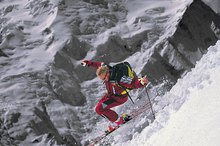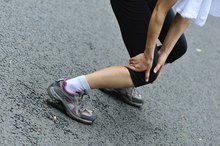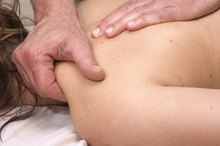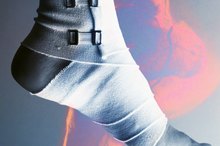Pack Vs. Powder in Snowboarding
Snow conditions are one of the most significant variables that impacts your boarding experience. The trail's texture and consistency influences your ability to maintain speed, cut turns and recover from falls. Fresh powder snow is typically regarded as the most desirable snow condition for snowboarding, but even ideal conditions require adjustments in riding style. Hard pack, though generally less desirable, has some advantages for riders who are interested in high-speed riding.
Types of Snow
Powder is fresh, dry snow that creates a soft layer on the trail. Powder creates a smooth, even surface on trails that many riders prefer. Natural snowfall and artificial snow can both produce powder-like conditions, though even just a few hours of traffic can pack down powder and diminish its soft, lightweight qualities. Packed snow can be either soft pack or hard pack. Soft pack is snow that has been compressed by traffic from riders or groomers, but it is not hard or ice-like. Hard pack, however, is the result of several days without fresh powder. Hard pack is solid and may have a thin layer of ice on the top.
Riding on Powder
How to Keep Your Legs From Aching From Skiing
Learn More
The surface created by powder is soft, smooth and even. For intermediate or advanced snowboards, the smooth surface creates ideal riding conditions. Board edges do not catch on ruts, ice patches or uneven surfaces. Instead, riders feel as if they are gliding on the surface of the snow, more similar to surfing than skiing. Powder tends to be deeper and more lightweight than packed snow. The reduced friction supports speed riding, but if you don't maintain consistent speed, you may experience sinking into the soft snow surface. For beginners, the snow depth may be intimidating, but softer conditions also mean more padding for falls, reducing the risk of injury. Fresh powder may camouflage obstacles or dangers like rocks, sticks or small shrubs.
Riding on Pack
Packed snow is a typical riding condition on most mountains and trails that are frequented by skiers or snowboarders. Packed snow often results in higher speed runs that require more edge gripping to maintaining control over the slippery conditions. Packed snow is preferred by some beginners because the risk of sinking is diminished and it's easier to pick up from a fall. However, packed snow also creates a harder riding surface, so falls are more painful.
Choosing Your Ride
What Effects Does Dancing Have on the Human Body?
Learn More
Packed snow may be better for beginners because it requires less strength than powder. Snowboarding in powder requires riders to lean into turns with their whole body in order to create enough momentum to plow through deeper snow. On packed snow, more subtle motions confined mostly to the lower body are enough to cause turns. Powder also requires consistent, sustained moderate speeds; riders who are prone to falling may struggle to reset their boards and pick up the trail again. Hard pack may also create icy conditions that can intimidate new riders and wear down board edges. Advanced riders will likely prefer the easier ride of powder snow, but if you are interested in racing, opt for hard pack and a freecarving board built for speed and agility.
Related Articles
References
Writer Bio
Hannah Wahlig began writing and editing professionally in 2001. Her experience includes copy for newspapers, journals and magazines, as well as book editing. She is also a certified lactation counselor. She holds a Bachelor of Arts in English from Mount Holyoke College, and Master's degrees in education and community psychology from the University of Massachusetts.









